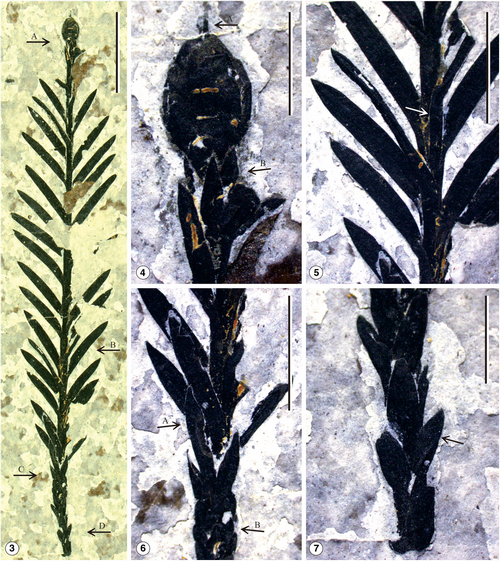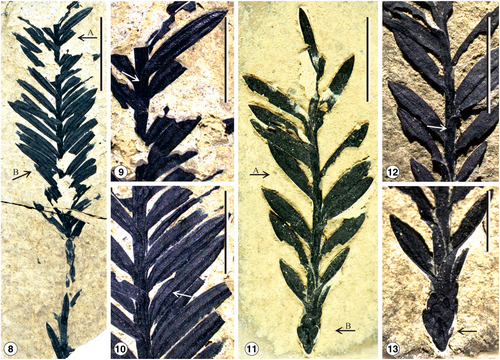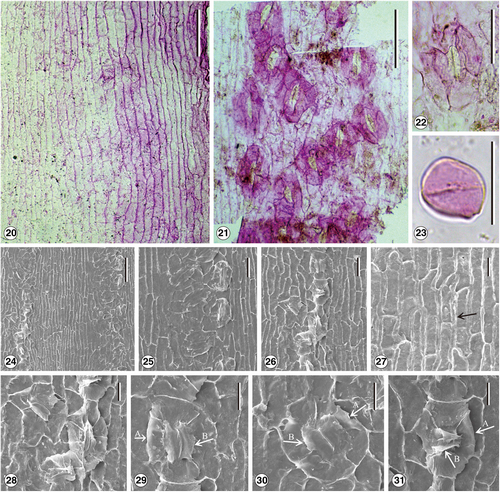中科院:冬春季干旱导致红杉在东亚灭绝

北美红杉(Sequoia sempervirens)是北美特有的一种大型乔木,现今仅分布于美国加利福尼亚少数地区,在地史上红杉属有较广泛的分布。研究红杉属的化石记录对于生物地理学研究,以及认识生物多样性对环境变化的响应具有重要的意义。中国科学院西双版纳热带植物园博士后张建伟在合作导师周浙昆研究员的指导下,于云南马关和文山的上中新统小龙潭组地层中发现了大量保存精美的红杉属化石,包括雄球果、鳞叶、条形叶和原位花粉,经研究这些化石被确定为新种:马关红杉(Sequoia maguanensis)。
马关中新世地层发现红杉化石表明:1)红杉化石的形态特征与现代红杉已经非常相近,马关红杉与北美红杉有最近的亲缘关系;2)白令陆桥在中新世对东亚和北美的区系交流仍然起着重要作用;3)北美红杉在云南的灭绝与东亚冬季风增强有关,北美红杉的种子每年12月份成熟,他们种子萌发和幼苗生长的时间都在冬春季。而晚中新世以来,东亚季风的显著增强导致了云南冬、春两季的降雨量日趋减少,从而阻碍了北美红杉的幼苗生长,导致北美红杉逐渐在云南的灭绝。北美红杉的现代分布区都属于地中海型气候,降雨大多在冬春季,与东亚季风气候区的降雨特征刚好相反,地中海型气候的降雨在冬春季与红杉种子成熟的时间吻合,满足了北美红杉种子萌发和幼苗生长的需求,使得其在地中海型气候下得以存活至今。
这一结果已经正式发表在American Journal of Botany。此研究得到了国家自然科学基金(NO.41372035)和版纳植物园“135”计划(方向一)的资助。近期,古生态组围绕新近纪季风气候增强对生物多样性的影响开展研究,其相关成果已发表在Paleobiology、Palaeogeography, Palaeoclimatology, Palaeoecology、Quaternary Research 等相关国际学术期刊。




马关红杉(Sequoia maguanensis)化石
Premise of the study: The paleogeographical origin of the relict North American Sequoia sempervirens is controversial. Fossil records indicate a NeoGENE origin for its foliage characteristics. Although several fossils from the Miocene sediments in eastern Asia have been considered to have close affinities with the modern S. sempervirens, they lack the typical features of a leafy twig bearing linear as well as scale leaves, and the fertile shoots terminating by a cone. The taxonomic status of these fossils has remained unclear.
• Methods: New better-preserved fossils from the upper Miocene of China indicate a new species of Sequoia. This finding not only confirms the former presence of this genus in eastern Asia, but it also confirms the affinity of this Asian form to the modern relict S. sempervirens.
• Key results: The principal foliage characteristics of S. sempervirens had already originated by the late Miocene. The eastern Asian records probably imply a Beringian biogeographic track of the ancestor of S. sempervirens in the early Neogene, at a time when the land bridge was not too cool for this thermophilic conifer to spread between Asia and North America.
• Conclusions: The climatic context of the new fossil Sequoia in Southeast Yunnan, based on other floristic elements of the fossil asseMBLage in which it is found, is presumed to be warm and humid. Following the uplift of the Qinghai-Tibet Plateau, this warm, humid climate was replaced by the present monsoonal climate with dry winter and spring. This change may have led to the disappearance of this hygrophilous conifer from eastern Asia.
作者:Jian-Wei Zhang

